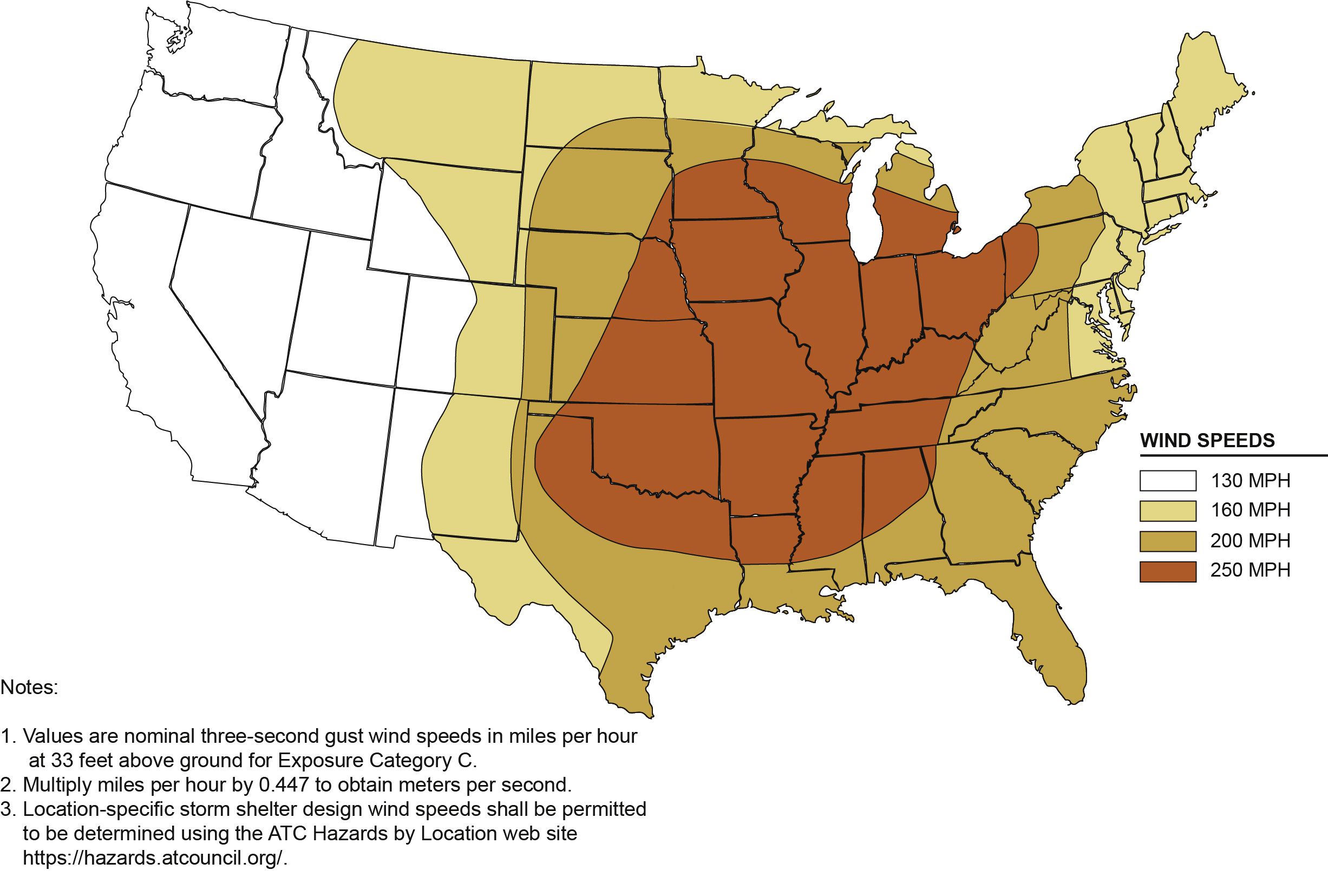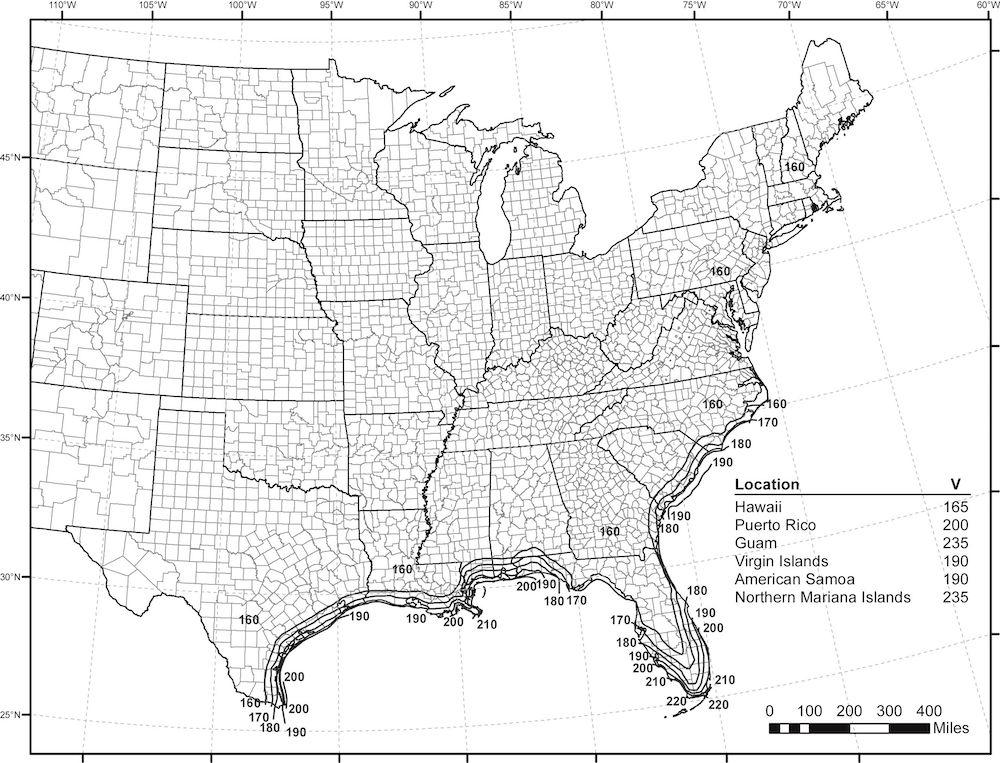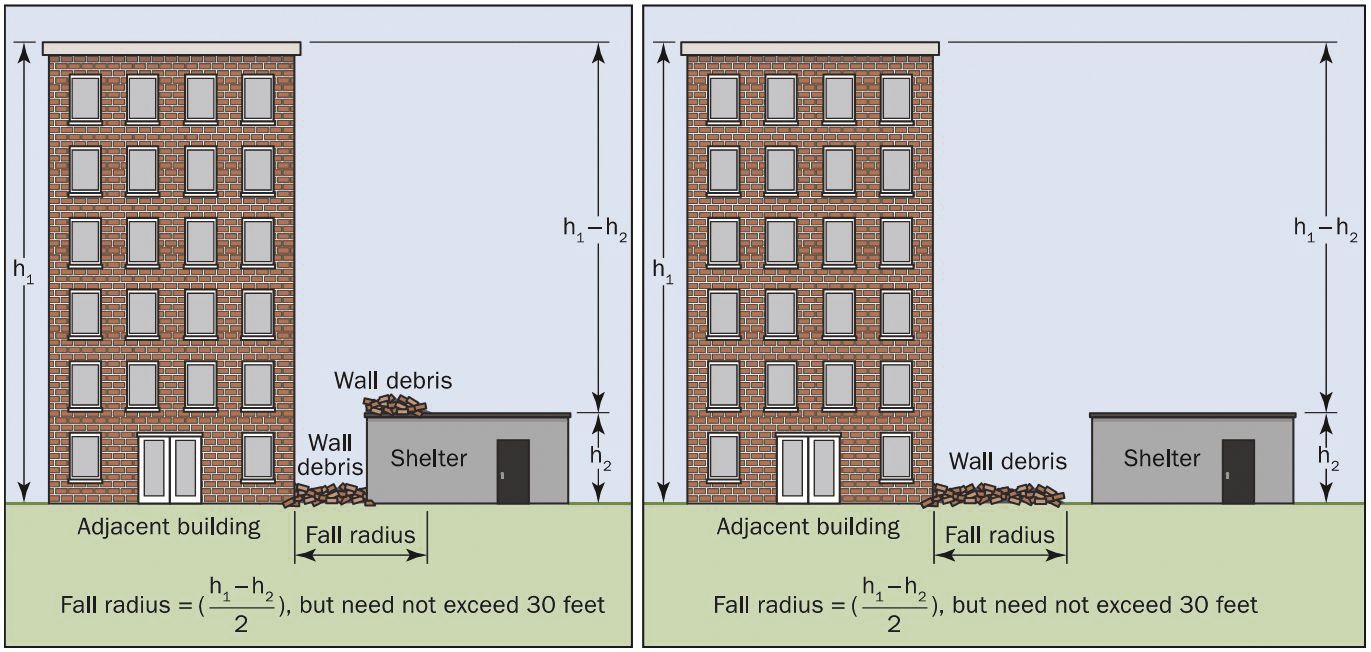In December 2020, the International Code Council, Inc. (ICC) and National Storm Shelter Association (NSSA) jointly published the third edition of the ICC/NSSA 500 Standard for the Design and Construction of Storm Shelters. Referenced in the 2021 International Building Code (IBC) and 2021 International Existing Building Code (IEBC), ICC 500-2020 establishes minimum design, construction, and inspection requirements for tornado and hurricane storm shelters. This article reviews when a storm shelter is required, the significant changes in the 2020 edition, and how the changes impact the practicing structural engineer.

When is a Storm Shelter Required?
The governing building code, typically IBC for new construction or IEBC for alterations and additions to existing construction, dictates when an ICC 500-compliant storm shelter is required. Storm shelter provisions vary depending on the version of IBC or IEBC adopted by the local jurisdiction. The 2009 IBC adopted the inaugural ICC 500-2008 as the governing document if an Owner elected to construct a storm shelter. Mandatory language first appeared in Section 423 of the 2015 IBC. This language required critical emergency operations and most Group E occupancies (i.e., K-12 schools) within a substantial portion of the central United States bounded by the 250 mph tornado wind speed zone (Figure 1) to provide an ICC 500-compliant storm shelter. Critical emergency operations include 911 call stations, emergency operation centers, and fire, rescue, ambulance, and police stations. Exemptions to the Group E occupancy shelter mandate include daycare facilities, accessories to a place of worship, and K-12 schools with an occupant load of less than 50. Since the 2015 IBC, building types requiring a storm shelter have not changed, although provisions for these projects have expanded.
The 2018 IBC introduced K-12 school shelter location limits and occupant capacity requirements. These new provisions intend to minimize travel distance from the host building to the shelter and provide sufficient capacity for the entire campus population, whether during normal operations or as an assembly space during a special event.
Storm shelters were not explicitly required for existing building projects until the 2018 IEBC. Initially, the 2018 IEBC (Chapter 11, Additions, Section 1106) established requirements for K-12 school additions that increase the occupant load by 50 or more, acknowledging the prevalence of K-12 addition projects. Like the IBC, the 2018 IEBC required new shelters to have the capacity to house all occupants on the campus, with certain exceptions. The 2021 IEBC relocated the storm shelter provisions to Chapter 3, Provisions for All Compliance Methods, Section 303, to encompass the prescriptive, work area, and performance compliance methods. For school renovation projects, the storm shelter typically consists of several new classrooms bounded together, unless more extensive renovations are planned to provide gymnasiums or multi-purpose rooms, which are the more common storm shelter locations for new construction.
While most states recognize storm shelter construction provisions, some local jurisdictions have yet to adopt the 2015 IBC (or later). Consequently, jurisdictions such as Illinois, Alabama, and Puerto Rico have passed legislation that directly adopts ICC 500 and requires a storm shelter in new K-12 schools.
With development of 2024 IBC underway, ICC 500-2020 is expected to remain the referenced standard for storm shelter design, construction, and inspection. Additionally, the 2024 IBC will recognize the recently developed Chapter 32, Tornado Loads, from the American Society of Civil Engineers (ASCE) Minimum Design Loads and Associated Criteria for Buildings and Other Structures (ASCE 7-22). While there is overlap in the general approach to calculate wind loads from tornadoes (WT) in ICC 500-2020 and tornado loads (WT) in ASCE 7-22 Chapter 32, the respective standards incorporate different hazard maps, adopt different trigger provisions, and ultimately, seek different performance objectives. Therefore, for 2024 IBC projects requiring an ICC 500 storm shelter, structural engineers will need to follow two independent design processes: 1) for the overall building tornado-resistant design (ASCE 7-22, Chapter 32), and 2) for the storm shelter design (ICC 500-2020).
Significant Changes to the ICC 500-2020
Owner’s Responsibility for Operations and Maintenance
ICC 500-2020, Sections 108 and 113, include new information about the storm shelter’s Owner’s responsibility to maintain shelters and ensure they are in good working order. ICC 500-2020 Section 108 (and accompanying Appendix A) requires that the Owner submit a written statement of responsibility and emergency preparedness plan to the Authority Having Jurisdiction (AHJ) during the permit process. Emergency preparedness plans include ongoing assessment of critical non-structural items such as ventilation, sanitation, lighting, fire extinguishers, first aid supplies, communication devices, food, and water. While Appendix A is not mandatory unless specifically adopted, the section assists Owners in developing their emergency preparedness plans with recommendations for personnel responsibilities, training and drills, community outreach, maintenance and evaluation, and shelter activation procedures.
ICC 500-2020 Section 113 now requires annual evaluations of the storm shelter envelope and impact-protective systems. Storm shelters are often constructed with cast-in-place concrete, or prestressed, precast concrete, which may be prone to deterioration mechanisms such as chloride contamination, corrosion of embedded reinforcement, or freeze-thaw damage. Accordingly, shelter owners should consider addressing leaks in walls and roofs as soon as they appear to prevent damage to the underlying structure. In addition to the visual inspections required by ICC-500, shelter owners should consider employing hammer-sounding and non-destructive evaluation (NDE) methods such as impact-echo to identify incipient structural defects. Concrete adjacent to roadways and sidewalks can be especially susceptible to damage in cold climates where deicing salts are used. Distress to below-grade or partially-below-grade shelters can be hidden from view by soil or vegetation. Shelter owners should carefully evaluate roofs and walls of below-grade shelters exhibiting cracks or signs of water infiltration, such as leaking or efflorescence staining.
Peer Review
ICC 500-2020, Section 109, requires a third-party peer review for community storm shelters with an occupant load of 50 or greater, shelters in schools with an occupant load greater than 16, and shelters in all Risk Category IV structures. Peer review is an important quality assurance measure and is particularly critical for a relatively new and developing standard such as ICC 500, with nuances unfamiliar to many practitioners. ICC 500-2020 now requires the peer reviewer to demonstrate their training and experience reviewing or designing storm shelters similar in complexity to the type of shelter under review. The peer reviewer also must disclose any potential conflicts of interest to the AHJ. Lastly, ICC 500-2020 requires additional rounds of peer review if the registered design professional changes the shelter’s main windforce-resistance system or components and cladding after the peer review is complete and before the issuance of permits. While the former is unlikely, the latter may be more common as exterior wall components are more likely to be revised during the deferred submittal process.

Changes in ICC 500-2020 Impacting the Structural Engineer
Structural Loads and Debris Hazard Updates
While the tornado wind speed contours (Figure 1) remain unchanged from previous versions of ICC 500, the 2020 version of ICC-500 includes updated hurricane wind speeds incorporating climatology data through the 2018 hurricane season, which parallels recent developments in ASCE 7-22 (Figure 2). Figure 2 also includes a table with design wind speeds for Hawaii and US Island Territories.
In addition to resisting wind pressures, ICC 500-2020 also requires roofs to be designed for extreme roof live loads: 100 psf for tornado shelters and 50 psf for hurricane shelters. Furthermore, storm shelter designers may need to consider vehicle loads (e.g., on below-grade shelters) following the applicable building code. ASCE 7-16 states that the design of trucks and busses shall be per AASHTO LRFD Bridge Design Specifications without the fatigue dynamic load allowance provisions. ICC 500-2020 also requires that floor live loads for tornado shelters be assembly occupancy live loads (e.g., 100 psf in the case of ASCE 7-16) and floor live loads for hurricane shelter floors be the same as the normal occupancy of the space.

One of the most significant structural changes to ICC 500-2020 is more explicit language on laydown and falling debris hazards. Before the 2020 edition, ICC 500 vaguely noted that designers should consider other debris hazards when determining the location of shelters on the site. Other debris hazards were noted to include laydown, rollover, and collapse hazards; however, there was no guidance assessing the presence of these hazards and, if necessary, what loads they would impose on the structure. ICC 500-2020 Section 305.3 now omits the term “other debris hazard” to explicitly addresses laydown and falling debris hazards, removes rollover hazards, and encompasses collapse hazards in the new definition of laydown hazard. In addition, section 305.3 expanded to include criteria for determining if designers need to consider falling debris loads in shelter design. Debris hazards are present from taller adjacent buildings or other structures such as communication towers, taller sections of the host building, or large trees that may fall onto a shelter located within the hazard’s fall radius. Figure 3 provides an example of the laydown of a communications tower onto a building resulting from a hurricane. Figure 4 illustrates the fall radius defined in ICC 500-2020 for the example of a multi-story building adjacent to a shelter.

Shelter designers must multiply falling debris loads by a minimum factor of 2.0 to account for dynamic effects and apply falling debris loads simultaneously with the uniform roof live load. If there are multiple laydowns and falling hazards, each hazard can be considered individually and not concurrently.
Closing
Referenced in the 2021 IBC and 2021 IEBC, ICC 500-2020 establishes minimum design, construction, and inspection requirements for tornado and hurricane storm shelters. This article reviews when a storm shelter is required, new and revised provisions in the 2020 edition, and how the changes impact practicing structural engineers. These changes include Owners’ responsibility for ongoing operations and maintenance; peer review qualifications and requirements; live load and hurricane storm shelter wind load updates; and prescriptive criteria for determining whether laydown or falling debris hazard is applicable.
References
Figures 304.2(1) and 302.4(2). Adapted from the ICC/NSSA Standard for the Design and Construction of Storm Shelters—2020 (ICC 500— 2020). Copyright 2020. Washington, D.C.: International Code Council. All rights reserved. Reprinted with permission. www.ICCSAFE.org
The tornado loads specified in ASCE 7-22 Chapter 32 provide reasonable consistency with the reliability delivered by the criteria in ASCE 7-22 Chapters 26 and 27 for main wind force resisting systems, and therefore are only required for Risk Category III and IV buildings and other structures. The design tornado speed will range from approximately Enhanced Fujita Scale EF0 – EF2 intensity. Storm shelters may be constructed as an option for protection of life and property for more intense tornados. A building designed for tornado loads determined exclusively in accordance with ASCE 7-22 Chapter 32 cannot be designated as a storm shelter without meeting additional critical requirements provided in the applicable building code and ICC 500.
Ref. User Note in Section 32.1.1 of ASCE 7
